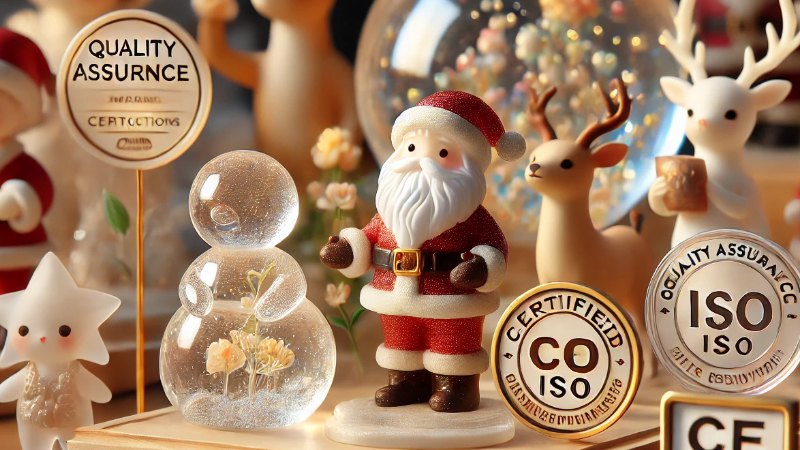
When it comes to resin products, whether you're designing or purchasing them, it's crucial to know what makes a product stand out in terms of quality. After all, not all resin is created equal, and recognizing the difference can make or break your project.
To identify a high-quality resin product, look for clear resin with minimal bubbles, smooth finishes, and precise craftsmanship. The material should be durable, non-toxic, and able to hold intricate designs without distortion.
Let’s dive into the key factors that will help you distinguish quality resin from the rest.
What are the indicators of superior resin material?
How can you tell if the resin material is high-quality?
Superior resin materials are clear, bubble-free, and have a consistent texture. High-quality resins also have strong adhesion properties and are non-toxic, making them suitable for a wide range of applications, from décor to jewelry.

Key Indicators of Superior Resin
- Clarity: High-quality resin should be clear and free from imperfections. If the resin is cloudy or has visible bubbles, it’s likely not of the highest standard. Clear resin1 is essential for achieving the perfect finish in your craft projects.
- Smooth Texture: The texture should be smooth to the touch. Any rough or uneven surfaces indicate poor-quality resin. For tips on achieving a flawless texture, check out how to smooth resin surfaces2.
- Durability: Superior resin should be tough and scratch-resistant. It shouldn’t yellow over time and should withstand wear and tear.
- Non-toxicity: Always check if the resin is non-toxic, especially if you're working with products that come into direct contact with skin or food.
My Experience with Resin Materials
When I first started working with resin, I quickly learned the importance of clarity. It was a frustrating experience trying to work with cloudy resin, which didn’t only look bad but also affected the final product's appeal. Now, I always test the material before committing to a large order.
What craftsmanship details should you observe?
What craftsmanship traits make a resin product truly stand out?
Attention to detail is key in resin craftsmanship. The best resin pieces show flawless finishing, with crisp edges, well-executed designs, and smooth transitions between different layers of material.

Craftsmanship Elements to Look For
- Edge Precision: The edges of a resin product should be smooth and even, with no jagged or uneven spots. Edge finishing3 is a critical aspect that elevates a resin piece to a professional level.
- Design Consistency: If the piece has patterns, shapes, or embedded materials, they should be uniformly placed and well-executed. Check out tips for designing with resin4 to ensure consistency in your projects.
- Layering: For multi-layered resin products, each layer should be perfectly smooth, with no visible gaps between layers.
- Finishing Touches: A high-quality resin product will have a glossy finish and be free from fingerprints, smudges, or dust particles.
Craftsmanship Insights
I’ve found that one of the biggest signs of quality craftsmanship is the way the resin is polished. I often look for a high-gloss finish because it shows that the artisan has spent time ensuring the surface is perfect, not just functional.
What certifications and quality assurance marks indicate quality?
Which certifications should you look for when evaluating resin products?
Certifications and quality assurance marks are a reliable way to ensure that resin products meet industry standards for safety, durability, and environmental impact.

Key Certifications for Resin Products
- CE Certification: This certification indicates that the product conforms to European safety standards. CE mark5 is essential for ensuring the safety of resin products in the European market.
- ISO Certifications: ISO standards indicate that the resin was produced in a factory adhering to international quality management standards. You can learn more about ISO quality standards6 to ensure the best materials are used in your resin products.
- RoHS Certification: Ensures that the resin is free from hazardous materials, making it safer for use in consumer products.
- FDA Approval: If the resin is intended for use in food-related items, FDA approval guarantees that it’s safe for direct contact with food.
The Importance of Certification
I’ve learned to always request certificates from suppliers before making large purchases. It gives me peace of mind knowing that the products I’m sourcing meet the necessary safety and quality requirements.
How do customer reviews and testimonials serve as quality signals?
Can customer reviews help you assess resin quality?
Customer reviews are a great way to gauge the real-world performance of resin products. Positive testimonials often reflect satisfaction with the product’s quality, while negative reviews can alert you to potential issues.

What to Look for in Customer Reviews
- Feedback on Durability: Customers often mention how well the resin holds up over time. Look for comments about whether the product remains clear, durable, and free from cracks or discoloration. Check out how to evaluate resin durability7 when reading product reviews.
- Aesthetic Appreciation: Pay attention to reviews that highlight the visual appeal of the resin item. Consistent praise for color clarity and design often points to quality materials and craftsmanship. Learn more about resin aesthetics8 to understand what makes a visually appealing piece.
- Customer Service: Quality resin suppliers typically have good customer service. Look for feedback on how responsive and helpful they are in resolving issues or answering questions.
Why Reviews Matter
I’ve always found that customer reviews can provide the best insight into a product's longevity and reliability. I once bought a batch of resin that looked great initially, but the reviews revealed that it yellowed over time. I learned the hard way, but it saved me from bigger losses in the future.
Conclusion
To identify high-quality resin products, look for clear material, excellent craftsmanship, proper certifications, and real-world feedback from customers.
-
This link highlights the importance of clarity in resin material, which is crucial for achieving high-quality results. ↩
-
This link provides tips on ensuring smooth texture, another key indicator of quality. ↩
-
This link highlights how crucial edge precision is for resin products, particularly when aiming for a professional, polished look. ↩
-
This link emphasizes how design consistency plays a key role in resin craftsmanship, helping ensure the patterns or shapes are neatly executed. ↩
-
This link clarifies the importance of CE certification, ensuring that resin products meet European safety standards. ↩
-
This link provides insight into the role of ISO certifications, which ensure the resin is produced in a high-quality, controlled environment. ↩
-
This link provides guidance on interpreting feedback regarding the durability of resin, helping readers understand what to look for in reviews about longevity. ↩
-
This link explains the importance of design and visual appeal in resin craftsmanship, offering insights into what quality resin products should look like. ↩





